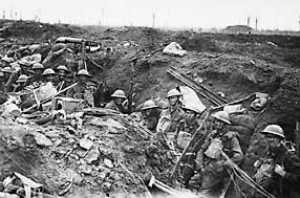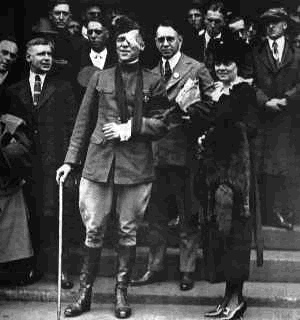Science of Conflict
Mutilation in the battle field
|
A major part of the First
World War was fought in trenches. A trench protected the body but left
the head and shoulders exposed. The head was vulnerable to projectiles
and shrapnel. Steel helmets were issued to protect the head but these
helmets only served to increase the horror of a facial injury when a
projectile heat as metal from the helmet would shatter and embed itself
in a soldier's face.
An American journalist, Floyd Gibbons, pictured below on the right,
wrote about the horrors of war while also himself experiencing the trauma
of requiring plastic surgery. The following is an excerpt from his biography,
written by his brother, Edward Gibbons.
|
|
| "Berry gave the order to advance, stepping out first himself,
with each man following at ten to fifteen yard intervals. Floyd was next
in line to Berry, with Hartzell next to Floyd. As they reached the middle
of the field German machine-gunners a hundred yards on their left, opened
up. Berry ordered everybody down, and they flattened themselves in the young
oats as best they could. Floyd looked up to see Major Berry, his right hand
holding the stump of what had been his left hand, still standing. Floyd
yelled to him to get down, and started inching towards him. Trying to hide
his movement from the German machine-gunners, Floyd crawled along, his left
cheek hugging the ground and his helmet pushed over the right, partly covering
his face on that side. Floyd had gotten but a few feet when a bullet hit
him in the left arm, just above the elbow, going in one side and out the
other. He continued to push himself forward. A few moments later another
bullet hit him in the left shoulder blade, still he inched on. Another five
feet along, a third bullet hit him, it ricocheted off a rock in the ground,
and with an upward course ripped out his left eye, continued on, making
a compound fracture of the skull, and finally coming out on the right side
of his helmet where it blew a hole three inches long (Floyd Gibbons at Belleau
Wood)." |
|
| The
excerpt above shows how violent trench warfare was, which, in many ways,
was different from all other forms of war because it placed opposing soldiers
in such close proximity. The inevitable result of trench warfare meant
a disproportionate number of facial injuries with the result of permanent
disfigurements. For many injured soldiers who had survived life threatening
injuries such as fractured jaws, mangled faces, fractured skulls and facial
burns, their problems were only just starting. As they returned home,
many discharged soldiers with gross facial injuries found it impossible
to find a job, meet a potential partner, or simply walk down the street
without receiving glances of disgust.
|
War created
the need for plastic surgery which was the seed for modern cosmetic surgery.
A surgeon, Max Thorek, pictured on the right, noted: “If soldiers
whose faces had been torn away by bursting shells on the battlefield could
come back into an almost normal life with new faces created by the wizardry
of the new science of plastic surgery, why couldn’t women whose
faces had been ravaged by nothing more explosive than the hand of the
years find again the firm clear contours of youth.”
|
|
|
|


